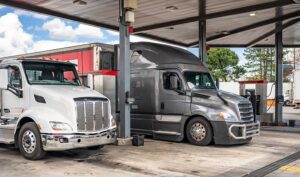2019 brought predictions of a looming recession, tariffs and trade wars, overcapacity in the freight market, and fears of diesel fuel price increases.
As the calendar turned to 2020, despite the potential pitfalls, 2019 turned out to be an OK year for many carriers.
So, what’s next? Will the economy slide into the predicted recession, or will the longest period in U.S. history without a recession continue?
“The United States economy will look about the same in 2020 as it did in 2019, but will improve in 2021,” is an opinion by Conerly Consulting Economist Bill Conerly, Ph.D. published in a recent Forbes magazine.
“International trade presents the greatest uncertainty to the economic outlook,” he continued, “and if that clears up, 2020 will be even better.”
Indeed, the worrisome predictions of a recession simply have not materialized.
“The risk of an economy-wide recession that was a growing concern through the third quarter of 2019 has largely faded, with healthy consumer fundamentals expected to provide sufficient momentum to get through the slow patch in industrial activity,” said ACT Research President and Senior Analyst Kenny Vieth.
“This is not a poor business environment,” said FTR Transportation Intelligence CV Equipment Expert Don Ake. “Freight levels are high after a couple of years of vibrant growth. Rates took a hit from the high prices in 2018 but have started to recover some. There is plenty of freight to haul, so well-managed fleets will be profitable, as poorly managed fleets go bankrupt due to the slowing of freight growth.”
The U.S. Bureau of Economic Analysis (BEA) reported the fourth quarter gross domestic product at an annualized rate of 2.1%, bringing the 2019 total growth to 2.3%. It wasn’t as good as the 2.9% achieved in 2018, but it was still positive.
Tariffs played a role in the 2019 GDP. Reduced exports meant fewer sales opportunities, adding downward pressure. At the same time, reduced imports meant more opportunity for U.S. manufacturers, pushing the GDP upward. How those pressures impacted trucking depends on the segment served. Those who haul a lot of import-export freight may have experienced a downturn, while those who haul mostly domestic freight may have seen a benefit.
A trade agreement between the U.S. and its largest trade partner China has been signed. The agreement covers about 25% of the products involved in the tariff dispute, but it paves the way for more agreement.
Another agreement that bodes well for trucking is the United States-Mexico-Canada Agreement (USMCA) that was signed into law Jan. 29. “This is a colossal victory for our farmers, ranchers, energy workers, factory workers, and American workers in all 50 states,” said President Donald Trump in a Rose Garden ceremony. “Today we are finally ending the NAFTA nightmare.” NAFTA, the North American Free Trade Agreement, was the predecessor of the USMCA.
The new agreement clarifies rules of origin for vehicles and other products that are assembled outside of the U.S. and sets limits on the number of parts that can be imported. The amount of cash Canadians can spend through U.S. online vendors without paying tariff was increased, and Canadian markets were opened to U.S. agricultural products.
There was some fear of fuel-price increases as the year turned over, both from the International Maritime Organization mandate for low-sulfur bunker oil (fuel) for ocean-going ships and from escalating tensions with Iran. Neither problem has materialized, and fuel prices remain steady.
Perhaps the largest factor impacting trucking for 2020 was the increase in fleet capacity. New trucks sold in record numbers during some months of 2019, and the year was the second-best ever. When strong growth in the 2018 economy increased, both freight availability and the rates to haul it, carriers increased capacity to maximize the revenue potential. Standard safety features and improved fuel economy of the newer models helped drive sales, too. The result was that the U.S. fleet of Class 8 tractors grew much faster than available freight did, slowing rate increases and eventually pressuring rates downward.
The overcapacity situation resulted in dire predictions for the last quarter of 2019 and into 2020.
Instead, orders for new Class 8 equipment slowed considerably as prior orders were filled, tempering the overcapacity situation.
Going into 2020, rates haven’t improved, but they haven’t fallen as far as some thought they would, either.
So where does that leave truck sales? “Flat freight growth means fleets do not need to expand,” said FTR’s Ake. “A growing economy and high freight volumes enables them to replace old units with minimal risk. So, we are left with only replacement demand.”
For carriers that are well run and who don’t overbuy new equipment, 2020 can be a profitable year. FTR is forecasting GDP growth of 1.7% for 2020, a few points below the 2019 level. ACT Research is slightly more generous, predicting 1.8% GDP growth. Conerly, in his Forbes piece, predicts GDP growth to closely resemble 2019’s result, possibly growing to as much as 2.6% before expanding to 3% in 2021.
All of the forecasters look to manufacturing as a possible drag on the economy. Ake points out that the ISM manufacturing index of 46.8% is the lowest it has been in 10 years.
Of course, any economic predictions for coming months can be impacted by events. Trump has announced unilateral tariff increases at various times in 2019, and he may not be finished. Ake quipped, “One tweet can change everything in a moment.” The U.S. and China may not come to agreement on the 75% of products not yet resolved. Tension between the U.S. and Iran remains high and could escalate.
The impeachment trial of President Trump ended in his acquittal, but it’s doubtful that the hateful rhetoric coming from both sides will subside.
As if the political climate wasn’t stormy enough, it’s an election year. Congress could remain deadlocked on a majority of issues, or it could see a sudden burst of cooperation as the two major parties attempt to get something done for their constituents. One item that is seeing increased attention is a replacement for the Fixing America’s Surface Transportation (FAST) Act, set to expire this year. Competing infrastructure proposals are in committee in both houses of Congress with a resolution expected prior to the November election. Neither proposal contains an answer to the question of how funds will be raised, but another bill currently in the House proposes a 25-cent raise in fuel taxes phased in over five years. Whether Congress has the stomach to consider a tax increase during an election year remains to be seen.
In closing, another cloud has appeared on the horizon and is growing fast. The Coronavirus is spreading rapidly, with no known method of immunization. While the coronavirus itself is a common cause of cold and flu symptoms, a strain originating in Hubei Province, China, is proving to be exceptionally virulent. Already impacting international travel, the virus could conceivably impact shipping and even manufacturing. No one knows how far it will spread or if the current form of the virus will evolve into a pandemic or simply a brief disruption.
Time will tell if 2020 ends up great or poor in economic terms, but most of the forecasters are anticipating a year that’s somewhere in between, right around “OK.”
Cliff Abbott is an experienced commercial vehicle driver and owner-operator who still holds a CDL in his home state of Alabama. In nearly 40 years in trucking, he’s been an instructor and trainer and has managed safety and recruiting operations for several carriers. Having never lost his love of the road, Cliff has written a book and hundreds of songs and has been writing for The Trucker for more than a decade.















